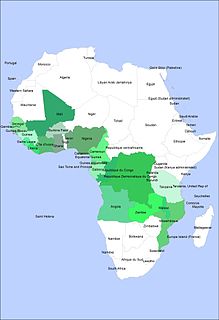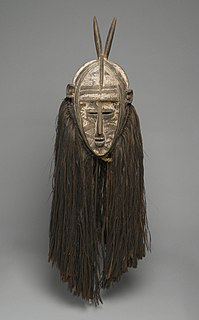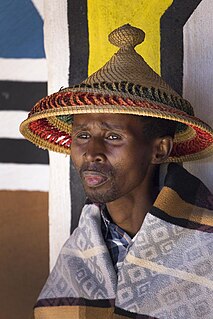Laws restricting, regulating, or banning circumcision, some dating back to ancient times, have been enacted in many countries and communities. In modern states, circumcision is generally presumed to be legal, but laws pertaining to assault or child custody have been applied in cases involving circumcision. In the case of non-therapeutic circumcision of children, proponents of laws in favor of the procedure often point to the rights of the parents or practitioners, namely the right of freedom of religion. Those against the procedure point to the boy's right of freedom from religion. In several court cases, judges have pointed to the irreversible nature of the act, the grievous harm to the boy's body, and the right to self-determination, and bodily integrity.

The Dogon are an ethnic group indigenous to the central plateau region of Mali, in West Africa, south of the Niger bend, near the city of Bandiagara, and in Burkina Faso. The population numbers between 400,000 and 800,000. They speak the Dogon languages, which are considered to constitute an independent branch of the Niger–Congo language family, meaning that they are not closely related to any other languages.
Religious male circumcision generally occurs shortly after birth, during childhood, or around puberty as part of a rite of passage. Circumcision is most prevalent in the religions of Judaism, Islam, Druze faith, and some Christian denominations such as the Coptic Orthodox Church, the Ethiopian Orthodox Church, and the Eritrean Orthodox Church.

The Mende are one of the two largest ethnic groups in Sierra Leone; their neighbours, the Temne people, have roughly the same population. Mende people account for slightly more than 30% of the total population. The Mende are predominantly found in the Southern Province and the Eastern Province, while the Temne are found primarily in the Northern Province and the Western Area, including the capital city of Freetown. Some of the major cities with significant Mende populations include Bo, Kenema, Kailahun, and Moyamba.

The Bukusu people are one of the seventeen Kenyan tribes of the Luhya Bantu people of East Africa residing mainly in the counties of Bungoma and Trans Nzoia. They are closely related to other Luhya people and the Gisu of Uganda. Calling themselves BaBukusu, they are the largest tribe of the Luhya nation, making up about 34% of the Luhya population. They speak the Bukusu dialect.

The Baga are a West African ethnic group who live in the southern swampy lands of Guinea Atlantic coastline. Traditionally animist through the pre-colonial times, they converted to Islam during the mid-eighteenth century under the influence of Muslim Mandé missionaries. Some continue to practice their traditional rituals.

Traditional African masks play an important role in certain traditional African rituals and ceremonies.
The Luvale people, also spelled Lovale, Balovale, Lubale, as well as Lwena or Luena in Angola, are a Bantu ethnic group found in northwestern Zambia and southeastern Angola. They are closely related to the Lunda and Ndembu to the northeast, but they also share cultural similarities to the Kaonde to the east, and to the Chokwe and Luchazi, important groups of eastern Angola.

The Balanta are an ethnic group found in Guinea-Bissau, Guinea, Senegal and The Gambia. They are the largest ethnic group of Guinea-Bissau, representing more than one-quarter of the population. Despite their numbers, they have remained outside the colonial and postcolonial state because of their social organisation. The Balanta can be divided into six clans: Nhacra, Ganja (Mane), Naga, Patch, Sofa and Kentohe. The largest of which are the Balanta Kentohe.
The Songye people, sometimes written Songe, are a Bantu ethnic group from the central Democratic Republic of the Congo. They inhabit a vast territory between the Sankuru and Lubilash rivers in the west and the Lualaba River in the east. Many Songye villages can be found in present-day East Kasai province, parts of Katanga and Kivu Province. The people of Songye are divided into thirty-four conglomerate societies; each society is led by a single chief with a Judiciary Council of elders and nobles (bilolo). Smaller kingdoms east of the Lomami River refer to themselves as Songye, other kingdoms in the west, refer to themselves as Kalebwe, Eki, Ilande, Bala, Chofwe, Sanga and Tempa. As a society, the people of Songye are mainly known as a farming community; they do, however, take part in hunting and trading with other neighboring communities.
Forced circumcision is the circumcision of men and children against their will. In a biblical context, the term is used especially in relation to Paul the Apostle and his polemics against the circumcision controversy in early Christianity. Forced circumcisions have occurred in a wide range of situations, most notably in the compulsory conversion of non-Muslims to Islam and the forced circumcision of Teso, Turkana and Luo men in Kenya, as well as the abduction of South African teenage boys to so-called circumcision schools. In South Africa, custom allows uncircumcised Xhosa-speaking men past the age of circumcision to be overpowered by other men and forcibly circumcised.
The Mbole people are an ethnic group of about 150,000 people living in the Orientale Province, southwest of Kisangani in the Democratic Republic of the Congo. The Mbole were previously referred to as Bambole.
The Saafi people, also called Serer-Safene, Safene, etc., are an ethnic group found in Senegal. Ethnically, they are part of the Serer people but do not speak the Serer language nor a dialect of it. Their language Saafi is classed as one of the Cangin languages. In Senegal, they occupy Dakar and the Thies Region.

The Ndut is a rite of passage as well as a religious education commanded by Serer religion that every Serer must go through once in their lifetime. The Serer people being an ethnoreligious group, the Ndut initiation rite is also linked to Serer culture. From the moment a Serer child is born, education plays a pivotal role throughout their life cycle. The ndut is one of these phases of their life cycle. In Serer society, education lasts a lifetime, from infancy to old age.

The Bushong Kuba are responsible for some of the most beautiful and sophisticated masquerade or dance traditions in Africa.
The name Makonde art refers to East African sculptures or, less frequently, to modern paintings created by craftspeople or artists belonging to the Makonde people of northern Mozambique and southern Tanzania, separated by the Ruvuma river. Art historians, dealers and collectors have created this genre of African art, that can be subdivided into African traditional artifacts or modern artistic works. This genre can be traced back to the 1930s, when the first documented exhibition of Makonde art was held at the Centro Cultural dos Novos in Mozambique.

Ulwaluko, traditional circumcision and initiation from childhood to adulthood, is an ancient initiation rite practised by the Xhosa people, and is commonly practised throughout South Africa. The ritual is traditionally intended as a teaching institution, to prepare young males for the responsibilities of manhood. Therefore, initiates are called abakhwetha in isiXhosa: aba means a group, and kwetha means to learn. A single male in the group is known as an umkhwetha. A male who has not undergone initiation is referred to as inkwenkwe (boy), regardless of his age, and is not allowed to take part in male activities such as tribal meetings.

Burkina Faso is a small, landlocked country north of Ghana and south of Mali and Niger. Economically, it is one of the four or five poorest countries in the world. Culturally, it is extremely rich. In part this is because so few people from Burkina have become Muslim or Christian. Many of the ancient artistic traditions for which Africa is so well known have been preserved in Burkina Faso because so many people continue to honor the ancestral spirits, and the spirits of nature. In great part they honor the spirits through the use of masks and carved figures. Many of the countries to the north of Burkina Faso had become predominantly Muslim, while many of the countries to the south of Burkina Faso are heavily Christian. In contrast many of the people of Burkina Faso continue to offer prayers and sacrifices to the spirits of nature and to the spirits of their ancestors. The result is that they continue to use the sorts of art that we see in museums in Europe and America.
Circumcision in Africa, and the rites of initiation in Africa, as well as "the frequent resemblance between details of ceremonial procedure in areas thousands of kilometres apart, indicate that the circumcision ritual has an old tradition behind it and in its present form is the result of a long process of development."

Lebollo la banna is a Sesotho term for male initiation.















